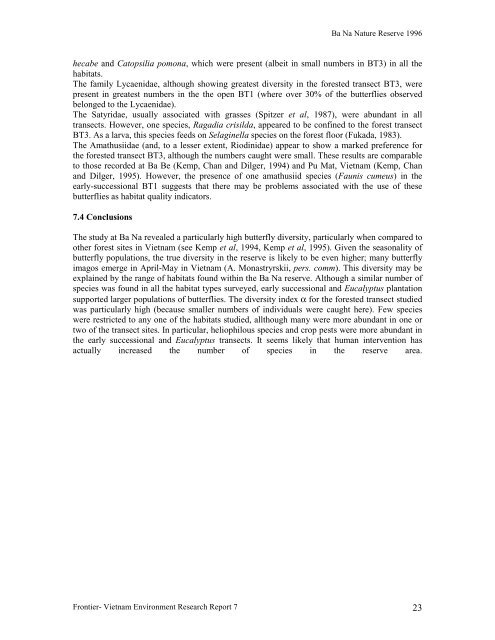Frontier Tanzania Environmental Research - Frontier-publications ...
Frontier Tanzania Environmental Research - Frontier-publications ...
Frontier Tanzania Environmental Research - Frontier-publications ...
You also want an ePaper? Increase the reach of your titles
YUMPU automatically turns print PDFs into web optimized ePapers that Google loves.
Ba Na Nature Reserve 1996<br />
hecabe and Catopsilia pomona, which were present (albeit in small numbers in BT3) in all the<br />
habitats.<br />
The family Lycaenidae, although showing greatest diversity in the forested transect BT3, were<br />
present in greatest numbers in the the open BT1 (where over 30% of the butterflies observed<br />
belonged to the Lycaenidae).<br />
The Satyridae, usually associated with grasses (Spitzer et al, 1987), were abundant in all<br />
transects. However, one species, Ragadia crisilda, appeared to be confined to the forest transect<br />
BT3. As a larva, this species feeds on Selaginella species on the forest floor (Fukada, 1983).<br />
The Amathusiidae (and, to a lesser extent, Riodinidae) appear to show a marked preference for<br />
the forested transect BT3, although the numbers caught were small. These results are comparable<br />
to those recorded at Ba Be (Kemp, Chan and Dilger, 1994) and Pu Mat, Vietnam (Kemp, Chan<br />
and Dilger, 1995). However, the presence of one amathusiid species (Faunis cumeus) in the<br />
early-successional BT1 suggests that there may be problems associated with the use of these<br />
butterflies as habitat quality indicators.<br />
7.4 Conclusions<br />
The study at Ba Na revealed a particularly high butterfly diversity, particularly when compared to<br />
other forest sites in Vietnam (see Kemp et al, 1994, Kemp et al, 1995). Given the seasonality of<br />
butterfly populations, the true diversity in the reserve is likely to be even higher; many butterfly<br />
imagos emerge in April-May in Vietnam (A. Monastryrskii, pers. comm). This diversity may be<br />
explained by the range of habitats found within the Ba Na reserve. Although a similar number of<br />
species was found in all the habitat types surveyed, early successional and Eucalyptus plantation<br />
supported larger populations of butterflies. The diversity index α for the forested transect studied<br />
was particularly high (because smaller numbers of individuals were caught here). Few species<br />
were restricted to any one of the habitats studied, allthough many were more abundant in one or<br />
two of the transect sites. In particular, heliophilous species and crop pests were more abundant in<br />
the early successional and Eucalyptus transects. It seems likely that human intervention has<br />
actually increased the number of species in the reserve area.<br />
<strong>Frontier</strong>- Vietnam Environment <strong>Research</strong> Report 7 23
















